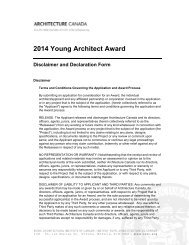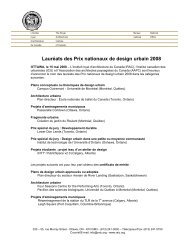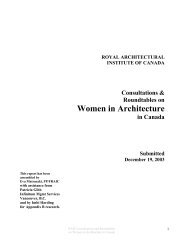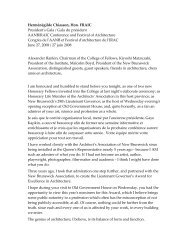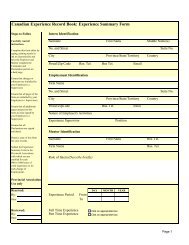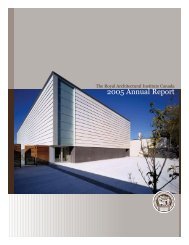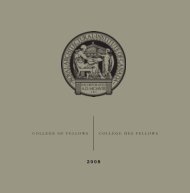Benchmark Study on Green Buildings - Royal Architectural Institute ...
Benchmark Study on Green Buildings - Royal Architectural Institute ...
Benchmark Study on Green Buildings - Royal Architectural Institute ...
You also want an ePaper? Increase the reach of your titles
YUMPU automatically turns print PDFs into web optimized ePapers that Google loves.
Fund supports a range of activities leading up to and including the physical<br />
implementati<strong>on</strong> of an envir<strong>on</strong>mental infrastructure project. The Fund distinguishes four<br />
types of project activities: planning, feasibility studies, field tests, and capital<br />
installati<strong>on</strong>/implementati<strong>on</strong>. Funding from the GMF is available in the form of loans,<br />
grants, and a combinati<strong>on</strong> of the two. Based <strong>on</strong> the potential envir<strong>on</strong>mental benefits of<br />
the capital project, the funding opti<strong>on</strong> ranges from a loan of up to 25% of Total Eligible<br />
Costs to a loan and grant combinati<strong>on</strong> of up to 80% and up to 50% of the Total Eligible<br />
Costs, respectively. The funding caps for eligible capital implementati<strong>on</strong> projects are<br />
loans of $50-70 milli<strong>on</strong> a year and grants of $7-10 milli<strong>on</strong> a year. The funding opti<strong>on</strong><br />
available to applicants for feasibility studies, field tests and sustainable community plans<br />
is a grant of up to 50% of the Total Eligible Costs to a maximum of $350,000. The<br />
funding cap for eligible feasibility studies, field tests and sustainable community plans is<br />
grants of $8-12 milli<strong>on</strong> a year. The GMF website<br />
(http://kn.fcm.ca/ev.php?URL_ID=2825&URL_DO=DO_TOPIC&URL_SECTION=201<br />
&reload=1096488899) can be c<strong>on</strong>sulted for eligibility criteria and a list of projects that<br />
can receive funding by the GMF.<br />
Municipal green building initiatives:<br />
Certain municipalities are also offering incentives for green building, and some are even<br />
mandating green requirements for new buildings. For example, Tor<strong>on</strong>to has introduced<br />
the <strong>Green</strong> Development Standard, which integrates existing city guidelines and targets<br />
with standards from green building rating systems such as LEED and <strong>Green</strong> Globes. The<br />
intent of this report is to describe what has been d<strong>on</strong>e by other cities, and to encourage<br />
the acti<strong>on</strong>s that were successful. The <strong>Green</strong> Development Standard is also being applied<br />
to all new city-owned and affiliated projects, helping the city promote its own green<br />
development package and lead by example. The <strong>Green</strong> Standard is helping make green<br />
building more appealing in the Tor<strong>on</strong>to area because it is a “made-in-Tor<strong>on</strong>to” approach<br />
and because it takes some of the uncertainties out of the development process. In<br />
Vancouver, the municipal government is amending existing building codes and bylaws to<br />
include more green features. These new bylaws state that a building rating of LEEDcertified<br />
or equivalent is the mandatory minimum level of achievement for all new<br />
buildings, and that the standard for civic buildings greater than 500m 2 is LEED-Gold<br />
certificati<strong>on</strong>, with energy efficiency levels 30% better than the MNECB.<br />
Infrastructure Canada infrastructure improvement programs:<br />
Infrastructure Canada is also funding several programs to improve the country’s<br />
infrastructure. The $4 billi<strong>on</strong> Canada Strategic Infrastructure Fund awards funding to<br />
projects of major federal and regi<strong>on</strong>al significance in areas that are vital to sustaining<br />
ec<strong>on</strong>omic growth and enhancing the Canadian quality of life. This means areas such as<br />
central business districts, urban green spaces and parks, and areas of unique importance<br />
will see improvements. The goals of this fund are the safer and faster movement of<br />
people and goods <strong>on</strong> Canada’s major land transportati<strong>on</strong> routes, reduced producti<strong>on</strong> of<br />
greenhouse gases and airborne pollutants, more-effective and sustainable urban<br />
development, increased ec<strong>on</strong>omic activity including tourism, and the use of innovative<br />
technologies and practices to increase the overall sustainability of the country. The<br />
Municipal Rural Infrastructure Program (MRIF) was announced in 2003 to support<br />
66



